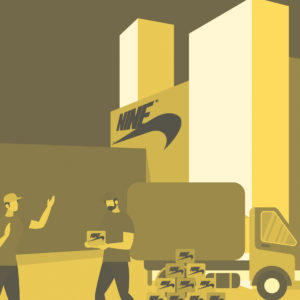Despite widespread awareness, many companies still don’t have a robust offensive against brand abuse. Brand protection is more crucial than ever to safeguard brand identity and should be an integral part of a brand’s overall anti-counterfeiting strategy. This raises the question: what exactly is brand protection and how can brands implement it?
The internet age is rife with malicious and opportunistic entities looking to benefit from the good name of established brands. Brand protection is a company’s sole weapon against the wide-ranging dangers of counterfeiting, IP theft, and impersonation.
We’ll describe the burning need for well-structured brand protection strategies. In addition, we’ll highlight the kinds of brand protection technology your business should implement to protect your brand without further delay.
Understanding Brand Protection – A Definition
Put simply, brand protection is a set of measures and safeguards put in place to minimize damage from brand abuse. Whether it’s clamping down on counterfeit products or fighting a copyright protection battle, you need technologically advanced brand protection strategies to successfully protect your brand’s identity.
And today, brand protection demands a lot more nuance and effort than in years past when lawsuits and publicity were sufficient to suppress malicious agents. The degree to which brand abuse has diversified and evolved over time is appalling and brand owners need to be aware of the potential risks it entails.
Types of Brand Abuse
Brand abuse is not limited to fake products or copyright infringements. These are simply two of the many forms it can take in today’s digital business era. Bad actors often don’t need to manufacture physical products to piggyback on a brand’s reputation. They can simply impersonate the brand’s website and social media accounts or flout patent rules. Let’s look at the different types of brand abuse in detail.

- Counterfeiting – A report by the OECD showed that the total value of counterfeit and pirated goods was estimated to reach $3 trillion in 2022. Counterfeiting relies on imitating the product packaging and brand name and passing it off as the real thing. It not only causes a revenue hit for the business but also damages the brand’s reputation.

- Gray market – The gray market deals in original products but sold without the brand’s permission through unauthorized distribution channels. Often, these involve selling goods in other countries by exporting them illegally.
- Intellectual Property theft – Malicious agents can also trade in services by using a brand’s copyright without permission. Digital goods like music, movies, video games, and more are often pirated and count as copyright piracy. IP theft can also occur if a brand’s name, registered trademarks, or original assets are used and distributed without permission.
- Fake websites – There are many instances of fake websites, slightly modified domain names, and claiming domain names of a brand’s trademarks. These rogue websites attempt to steal internet traffic from genuine websites to sell fake goods or profit off of the users’ trust.
- Social Media Impersonation – Brand abuse can also take the form of third parties hijacking genuine social media accounts or creating imitations to sell counterfeit products. Bad actors can also push malware or run phishing scams using the redirected traffic.
Two Sides of the Equation – Brand Owners and Consumers
Brand protection is a two-pronged approach: preserving the brand itself and preventing the end customers from abandoning their trust in the brand.
The potential impact of brand abuse on brand owners is immense. Sale of counterfeit products, IP theft and patent theft, and online impersonation can cause huge financial and reputational losses for brand owners. Although it isn’t always easy to measure its impact, brand abuse is simply too big to ignore.
On the other side, when customers buy inauthentic products, they don’t realize that they’ve been duped until something goes wrong. For instance, a consumer might believe they purchased a legitimate medical device. But after a short while, the fake device can malfunction and cause injury or even death.
Not only do consumers ultimately overpay for substandard quality, but they also stop trusting the brand and its products, leading to loss of revenue and trust for the brand.
It’s important to note that quantifying the damage to your business reputation isn’t simple. Do you look for an increased number of complaints, or, perhaps, a higher number of returned items? Filing lawsuits may have deterred criminals before, but today, legal actions are minimally effective at best. Simply put, criminals are bolder and more sophisticated than ever before.
Types of Brand Protection Services
The good news is that you’re not helpless against counterfeiting. There are many kinds of brand protection services available, some more effective than others. Also, detecting brand abuse is simply the first step, stopping it is another challenge entirely. Your brand protection strategy should include accurate reporting on top of the ability to capture vital data, preferably in real-time.
IP Portfolio Management
All your intellectual property should ideally reside in one place for its effective protection and management. You can use asset management systems to organize your digital assets and even outsource IP protection to third parties.
Threat Monitoring and Analysis
The task of collecting and analyzing data on all sources of brand abuse is immense but necessary. Depending on your industry, this can include monitoring for online and offline IP infringement, authentication of abuse, detecting counterfeiting products, and other measures.
You also need to use sophisticated methods to prioritize brand abuse threats so you know which ones you need to tackle first. A centralized system that can collect, organize, analyze, and extract information from all of your data is crucial to make this happen.
IP Protection
Enforcing IP protection is an integral part of your brand protection strategy. But it’s often a cripplingly difficult task to undertake. Determining the actual culprits, the kind of infringement committed, and then pursuing legal action against abusers can be much more difficult than you’d imagine.
It can sometimes be difficult to simply convince authorities that brand abuse has been committed. And even if you’re able to do that, it might be too late till an effective action is taken against the culprits.
Online Monitoring
In the wake of the pervasiveness of the internet and social media scammers, your brand needs to constantly monitor online counterfeiters on all social media platforms. Not only taking action against acts of brand abuse, but also predicting for more brand abuse incidents is the need of the hour.
Moreover, you also need to look out for counterfeiters on online marketplaces and take action as soon as a threat is identified. Time is of the essence in these proceedings.
Online advertising is another avenue for brand abuse. Brands selling physical or digital products need to monitor all online advertisements that attempt to direct users to counterfeit products by duping them with imitations and copyright infringements. Knockoffs are yet another major source of concern for brand owners worldwide.
Supply Chain Monitoring
Your supply chain is a major source of brand abuse as bad actors routinely redirect genuine products from within the supply chain to sell them in the gray market or for other nefarious purposes.
Brands can monitor their supply chain using innovative technological methods and also leverage their partners, distributors, and sellers to identify possible weak links that brand abusers can exploit.
Protect Your Brand With Technology
Minimum safeguards like consumer awareness and lawsuits don’t deter brand abusers. In a digitally connected world, it’s easy for a criminal to shift operations to a country that may not be friendly to IP laws and law enforcement. You can identify the problem, but stopping someone sitting across the planet from making rogue websites is easier said than done.
Technology can help you vastly improve your brand protection efforts, if implemented correctly. We, at AlpVision, believe that counterfeiters and cybercriminals shouldn’t be underestimated and should be tackled with innovative technological solutions for brands to stand a chance.
Counterfeiters are persistent and advanced con artists, so the brand protection system you deploy needs to account for those facts.
You need to use more advanced technology than what counterfeiters use to stay one step ahead of them. You can use tech to authenticate products as well as capture and analyze vital statistics in a centralized solution. This is what prompted us to develop AlpVision’s Brand Monitoring System (BMS).
AlpVision Brand Monitoring System
Global enterprises require global solutions that integrate into their current IT infrastructure. As such, AlpVision BMS is designed to be a server-based web application, allowing brand owners to monitor activity online, collect brand abuse statistics, and authenticate products when the system flags potential incidents. That’s how the system works at a high level, but AlpVision BMS provides additional brand protection safeguards as well.
Not only can our BMS solution help you identify counterfeit products, but it will also integrate seamlessly with our anti-counterfeiting solutions, such as AlpVision Fingerprint and Cryptoglyph. If you have a custom architecture, our brand monitoring software can also combine well with other tools, including secure QR codes, 2-D dot matrices, or something more covert.
AlpVision’s BMS process provides secure encryption and allows you to receive real-time information and notifications from any part of the world. With our online brand protection system, you can finally take control and minimize the damage to your IP and brand identity.
If you’d like to learn more specifics about the benefits of AlpVision BMS in combination with additional defenses, contact AlpVision today.
Contact AlpVision




